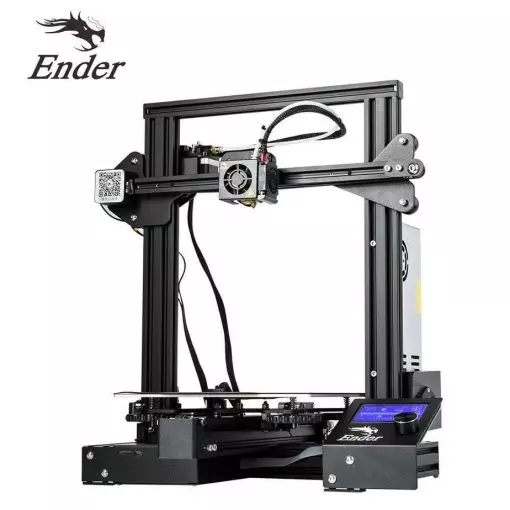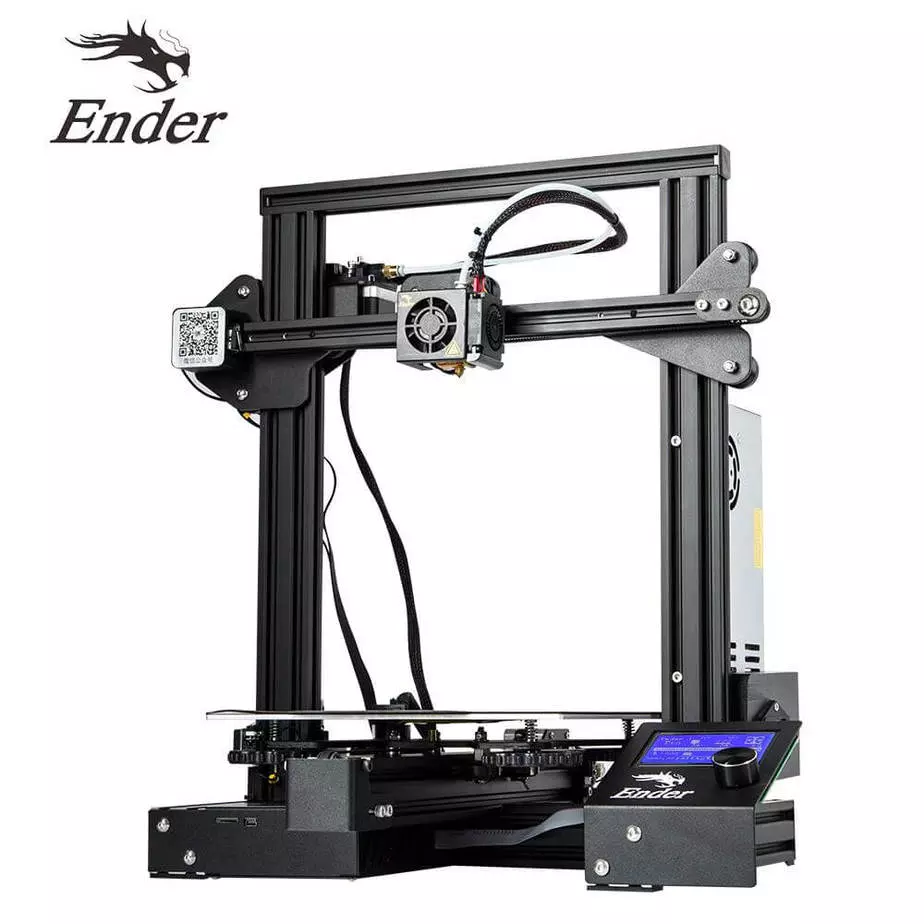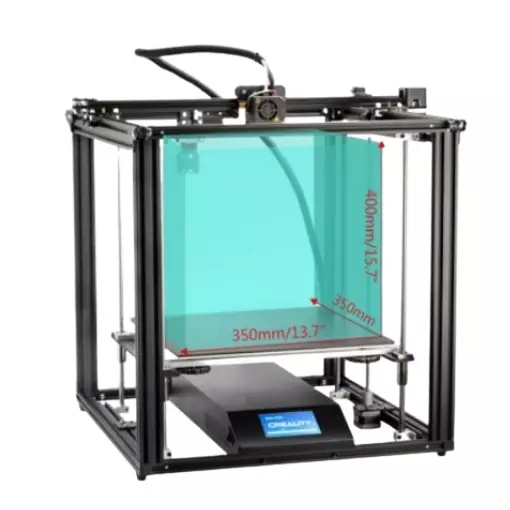Compare Ender 3 vs Ender 3 PRO vs Ender 5 Plus
Comparison between the best 3D printers
Choose the best 3D printer at the best price. The cheapest 3D printers are here.
Buy a 3D printer here with 3D Fila.
 |
 |
 |
|
| Model | Ender 3[BUY Ender 3] |
Ender 3 PRO[BUY Ender 3 PRO] |
Ender 5 Plus[BUY Ender 5 Plus] |
| Printing Material | Filament | Filament | Filament |
| Estimated price | $210,00 | $258,00 | $599,00 |
| Fabricante | Creality 3D | Creality 3D | Creality 3D |
| Release Year | 2018 | 2019 | 2019 |
| Print Volume [mm] | 220x220x250 | 220x220x250 | 350x350x400 |
| Printer Size [mm] | 440x440x465 | 440x440x465 | 632x619x666 |
| Weight [kg] | 6,62 | 6,62 | 18,2 |
| Power Loss Recovery | NO | NO | YES |
| Enclosed printer | NO | NO | NO |
| Bed Leveling | Manual | Manual | Automatic |
| Filament End Sensor | NO | NO | YES |
| Bed type | Heated | Heated | Heated |
| Power supply system | Bowden | Bowden | Bowden |
| Standard nozzle | 0,4 | 0,4 | 0,4 |
| Maximum Nozzle Temperature [°C] | 255 | 255 | 260 |
| Maximum Bed Temperature [°C] | 110 | 110 | 100 |
| Maximum printing speed [mm/s] | 180 | 180 | 180 |
| Filament holder | YES | YES | YES |
| Camera for supervision | NO | NO | NO |
| Recommended filaments | PLA, TPU, ABS, PETG | PLA, TPU, ABS, PETG | PLA, TPU, ABS, PETG |
| Recommended slicers | Cura, Simplify, Slic3r | Cura, Simplify, Slic3r | Cura, Simplify, Slic3r |
| Maximum Resolution [mm] | 0,1 | 0,1 | 0,1 |
| Processor | 8 bits | 32 bits | 32 bits |
| Display | Mono | Mono | Touchscreen TFT 4,3'' |
| Power Supply | 24V / 270W | 24V / 360W Meanwell | 24V / 504W |
| Connectivity | SD / USB | SD / USB | SD / USB |
| Operating systems | Windows, Mac, Linux | Windows, Mac, Linux | Windows, Mac, Linux |
| Date of registration in the system | 2021-04-13 | 2021-04-14 | 2021-04-14 |
| Release date | 2018 | 2019 | 2019 |
| Extra features | The Ender 3 V1 is a DIY assembly 3D printer, a sales leader since 2017, standing out for its cost-benefit. With a wide printing capacity, it has a CNC machined structure for precision and stability. It offers high-precision prints with low noise, thanks to its innovative V-profile and pulleys. It has a self-adhesive magnetic platform for easy removal of models and excellent adhesion. The Ender 3 heats up quickly, reaching 100°C in 5 minutes, ideal for agile prints. It includes protection against power failures, allowing you to resume printing after interruptions, saving time and material. | The Ender 3 Pro stands out for its beginner-friendly assembly and easily modifiable structure. With a 350W power supply, it heats up quickly and has a simple application that offers good print quality. However, its motors and fans are noisy, and the interface seems outdated. Assembly is accessible, without the need for advanced techniques, and it has integrated belt tensioners. It includes a detailed guide and supports microSD card and USB. | The Ender 5 Plus offers a large print volume (350x350x400 mm) and fast assembly. It includes a BLTouch sensor, but with range limitations. It stands out for its dimensional accuracy, although it requires adjustments to the slicer settings. Despite the noise, its integrated design saves space, and includes features such as a filament sensor and power resumption. Ideal for large projects, it requires refinement in the settings for high-quality prints. |
| Support for multiple colors and materials (AMS and CFS) | NO | NO | NO |
Notes * |
|||
| Cost-benefit | 6 / 10 | 6 / 10 | 6 / 10 |
| Hardware | 0.5 / 10 | 0.5 / 10 | 2 / 10 |
| Screen | . | . | . |
| Print volume | 3 / 10 | 3 / 10 | 4 / 10 |
| Performance | 1 / 10 | 1 / 10 | 1 / 10 |
| [BUY Ender 3] | [BUY Ender 3 PRO] | [BUY Ender 5 Plus] |
Conclusion |
| In comparing the Ender 3, Ender 3 Pro, and Ender 5 Plus 3D printers, several factors come into play that are pivotal for potential buyers. The **Ender 3** is lauded for its excellent cost-to-benefit ratio, making it an ideal choice for beginners and hobbyists who want a reliable and affordable printer. It offers a modest print volume with commendable print quality and features such as a magnetic platform for easy print removal and protection against power loss. The **Ender 3 Pro** builds on the strengths of its predecessor by providing an enhanced assembly experience and improved features like integrated belt tensioners, which add to its appeal for users looking to tweak and modify their setups. It maintains a similar print volume to the Ender 3 and serves well for general 3D printing needs, though it suffers from some noise issues and has a slightly outdated interface. In contrast, the **Ender 5 Plus** takes a step up in print volume and features automatic bed leveling and a filament end sensor, making it more suitable for larger projects and complex prints. Although it comes at a higher price point, its 32-bit processor and touchscreen interface enhance user experience. However, it requires careful adjustment of settings for optimal print quality. Ultimately, if budget is the primary concern, the **Ender 3** stands out as the best value. For those willing to spend a bit more for user-friendly enhancements and potential for upgrades, the **Ender 3 Pro** is a solid contender. The **Ender 5 Plus** is the choice for users needing a larger build volume and advanced features, though it does not provide the best cost-to-benefit ratio. Depending on individual needs, each printer presents a unique set of strengths that cater to different user requirements. |

